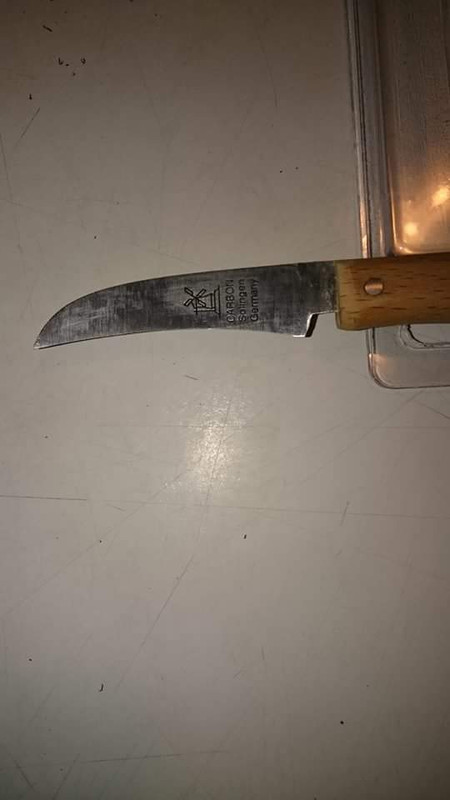You are using an out of date browser. It may not display this or other websites correctly.
You should upgrade or use an alternative browser.
You should upgrade or use an alternative browser.
How do you sharpen a bird's beak
- Thread starter Godslayer
- Start date

Help Support Kitchen Knife Forums:
This site may earn a commission from merchant affiliate
links, including eBay, Amazon, and others.
Ceramic rod. Easiest way.
Or if you want to get fancy, there are stones with a curved side.
https://www.sharpeningsupplies.com/Naniwa-Gouken-Curved-Water-Stone-P1605C4.aspx
https://www.sharpeningsupplies.com/Naniwa-Gouken-Curved-Water-Stone-P1605C4.aspx
I was gonna say that you have to hold the bird very still... [emoji16]
On a more serious note, would wrapping sandpaper around a dowel work?
Or even a PVC pipe that matches the radius of the edge?
On a more serious note, would wrapping sandpaper around a dowel work?
Or even a PVC pipe that matches the radius of the edge?
+1 to ceramic rod, i do quick touch ups on my mother in laws birds beak knives ever once in a while, i have a rough ceramic rod, followed by a loaded leather strop that i just so happen to have stretched over the sides, that way i can use the corners to strop it afterwards, i also occasionally use it for bread knife serrations. Works well enough for the purpose
- Joined
- May 3, 2011
- Messages
- 9,792
- Reaction score
- 4,507
I thin behind the edge on automotive sandpaper, up to the very edge. Blade flat. Don't have to care much about aesthetics as these are simple peelers. Create a very small bevel with scratches perpendicular to the edge on a stone's corner à la Zitangy. Deburring: clean up one side with rough split leather or cardboard and deburr the other side with a Sieger Long-life ceramic rod, and vice versa.
- Joined
- May 3, 2011
- Messages
- 9,792
- Reaction score
- 4,507
https://www.kitchenknifeforums.com/threads/german-asymmetry-a-peeler-knife.15749/
If the knife is used as a peeler by a right-handed, the most favourable geometry is an inverted one to what we are used to. So, left side convexed, right side as flat as possible, edge off-centered to the right. The flat, right side will lay under when peeling with the edge in your direction; the left, convexed side will help the peel coming off.
I do with peelers like Robert Herder and add a fat micro- (or mini-) bevel on the left, convexed side.
If the knife is used as a peeler by a right-handed, the most favourable geometry is an inverted one to what we are used to. So, left side convexed, right side as flat as possible, edge off-centered to the right. The flat, right side will lay under when peeling with the edge in your direction; the left, convexed side will help the peel coming off.
I do with peelers like Robert Herder and add a fat micro- (or mini-) bevel on the left, convexed side.
Last edited:
Keith Sinclair
Senior Member
This thread shows innovation as to whatever works for you.
Hopefully not tko much of a derail... but... I never really got the point of parrot beak knives. What's the idea behind the profile? I assume that they are used for peeling? If not, what else are they used for? What advantages do they have over a veggie peeler?
- Joined
- May 3, 2011
- Messages
- 9,792
- Reaction score
- 4,507
https://www.messerspezialist.de/tourniermesser.htmlHopefully not tko much of a derail... but... I never really got the point of parrot beak knives. What's the idea behind the profile? I assume that they are used for peeling? If not, what else are they used for? What advantages do they have over a veggie peeler?
Has to do with the traditional presentation of vegetables in the French kitchen, where e.g. carrots are cut as bulbs. The spherical form assures an even cuisson.
Thanks for the explanationhttps://www.messerspezialist.de/tourniermesser.html
Has to do with the traditional presentation of vegetables in the French kitchen, where e.g. carrots are cut as bulbs. The spherical form assures an even cuisson.
- Joined
- May 3, 2011
- Messages
- 9,792
- Reaction score
- 4,507
My pleasure, Nemo.Thanks for the explanation
- Joined
- May 3, 2011
- Messages
- 9,792
- Reaction score
- 4,507




